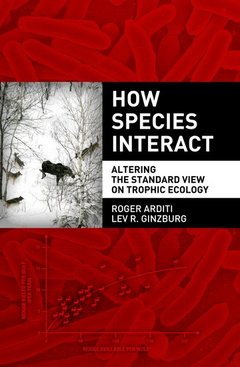How Species Interact Altering the Standard View on Trophic Ecology
Langue : Anglais
Auteurs : Arditi Roger, Ginzburg Lev

Understanding the functioning of ecosystems requires the understanding of the interactions between consumer species and their resources. How do these interactions affect the variations of population abundances? How do population abundances determine the impact of predators on their prey? The view defended in this book is that the "null model" that most ecologists tend to use is inappropriate because it assumes that the amount of prey consumed by each predator is insensitive to the number of conspecifics. The authors argue that the amount of prey available per predator, rather than the absolute abundance of prey, is the basic determinant of the dynamics of predation. This so-called ratio dependence is shown to be a much more reasonable "null model."
1. Alternative theories of trophic interaction. 1.1 Monod vs. Contois: resource-dependent and ratio-dependent bacteria. 1.2 The standard predator-prey model of ecology. 1.3 The Arditi-Ginzburg ratio-dependent model. 1.4 Donor control and ratio dependence. 1.5 Predator-dependent models. 1.6 What happens at low consumer density? The gradual interference hypothesis. 1.7 Biomass conversion. 2. Direct measurements of the functional response. 2.1 Insect predators and parasitoids, snails, fish, and others: laboratory measurements. 2.1.1 Manipulating the consumer density alone. 2.1.2 Measuring interference in the presence of a saturating functional response. 2.1.3 The Arditi-Akcakaya predator-dependent model. 2.1.4 Application to literature data. 2.1.5 Does interference increase gradually?. 2.2 Wasps and chrysomelids: a field experiment. 2.3 Wolves and moose: field observations. 2.3.1 Wolf social structure and spatial scales. 2.3.2 Model fitting and model selection methods. 2.3.3 The wolf-moose functional response is ratio-dependent. 2.4 Additional direct tests of ratio dependence. 2.4.1 Bark beetles. 2.4.2 Shrimps. 2.4.3 Egg parasitoids. 2.4.4 Benthic flatworms. 2.5 Identifying the functional response in time series. 3. Indirect evidence: food chain equilibria. 3.1 Cascading responses to harvesting at the top of the food chain. 3.2 Enrichment response when the number of trophic levels is fixed. 3.3 Enrichment response when the number of trophic levels increases with enrichment. 3.4 The paradox of enrichment. 3.5 Donor control and stability of food webs. 3.6 Why the world is green. 4. How gradual interference and ratio dependence emerge. 4.1 Experimental evidence of the role of predator clustering. 4.1.1 A microcosm experiment with cladocerans. 4.1.2 Predator aggregations lead to ratio dependence. 4.2 Refuges and donor control. 4.2.1 A simple exploratory theoretical model. 4.2.2 From donor control to ratio dependence. 4.3 The role of directed movements in the formation of population spatial structures. 4.3.1 Self-organization due to accelerated movement. 4.3.2 Spatially-structured predator-prey systems. 4.3.3 Generalization. 4.4 Ratio dependence and biological control. 4.4.1 The biological control paradox. 4.4.2 Trophotaxis and biological control. 4.5 Emergence of gradual interference: an individual-based approach. 4.5.1 A qualitative model based on predator home ranges. 4.5.2 An individual-based model based on trophotaxis. 5. The ratio dependence controversy. 5.1 How interference estimates can be wrong. 5.2 The paradox of enrichment and the cascading enrichment response: Is there any evidence that they exist? 5.3 The fallacy of instantism. 5.4 Are population cycles really caused by predation?. 5.5 Mechanistic vs. phenomenological theories. 5.6 "The truth is always in the middle": How much truth is in this statement?. 6. It must be beautiful. 6.1 Scale invariance and symmetries. 6.2 Kolmogorov's insight. 6.3 Akcakaya's ratio-dependent model for lynx-hare cycling. 6.4 The "limit myth". Appendices. 3.A Food chain responses to increased primary production. 3.A.1 Prey-dependent four-level food chain. 3.A.2 Ratio-dependent three-level food chain.
Roger Arditi is a distinguished professor at AgroParisTech in Paris, France. He works for INRA, the French National Institute for Agricultural Research, in the research unit of Ecology and Evolution at University Pierre et Marie Curie. His theoretical and experimental work is focused to basic questions of predation dynamics and applied work addresses agroecological problems. Lev R. Ginzburg has been a professor of ecology and evolution at Stony Brook University since 1977. He has published widely on theoretical and applied ecology, population genetics, and risk analysis. Ginzburg is co-author, with Mark Colyvan, of the popular title Ecological Orbits: How Planets Move and Populations Grow, published by Oxford University Press in 2004.
Date de parution : 05-2012
Ouvrage de 192 p.
23.6x15.5 cm
Thèmes de How Species Interact :
© 2024 LAVOISIER S.A.S.



